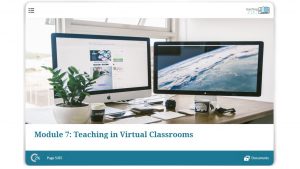Module 7 discusses how web conferencing software such as can be used effectively in teaching and learning environments. The five chapters focus on the following key topics:
- Let’s go virtual
- Skills and abilities of the VC teacher
- Planning an effective VC session
- Implementing an effective VC session
- Evaluating an effective VC session
Virtual classrooms provide a wide range of possibilities for connecting with students who are separated by time and space. The Module discusses how to prepare and run a VC session, taking a closer look at both the benefits and challenges associated with teaching in virtual classrooms. The Module shows in what ways a VC differs from a physical one, illustrating that teachers need to adopt a different strategy to engage visual learners.
The iLab manual Module 7 offers you additional information, useful links and helpful suggestions for Module 7 to enrich your teaching. Based on the cBook it can be used in everyday teaching to deepen some topics or in combination with the iLab (innovation Lab). The iLab is the two-day on-site training course of #Teaching2030, either provided by a project team member or organized in a self-directed way by university teachers. The iLab gives you the opportunity to try out new approaches, methods and competencies from the cBook.
 The University of Valencia was founded in 1499, nowadays it has become a modern European University open to almost every branch of knowledge. Given the wide range of studies offered, the University is now one of the largest, oldest and most diverse universities in Spain. In 90 departments, 17 institutes and other research units over 3,300 teachers and researchers carry out their work, aided by over 1,700 administration and service staff. Within this scope, The Department of Marketing of the Faculty of Economics incorporates 34 academic staff members who develop an intense teaching and research activity, which is pursued as key instrument of excellent performance.
The University of Valencia was founded in 1499, nowadays it has become a modern European University open to almost every branch of knowledge. Given the wide range of studies offered, the University is now one of the largest, oldest and most diverse universities in Spain. In 90 departments, 17 institutes and other research units over 3,300 teachers and researchers carry out their work, aided by over 1,700 administration and service staff. Within this scope, The Department of Marketing of the Faculty of Economics incorporates 34 academic staff members who develop an intense teaching and research activity, which is pursued as key instrument of excellent performance.

